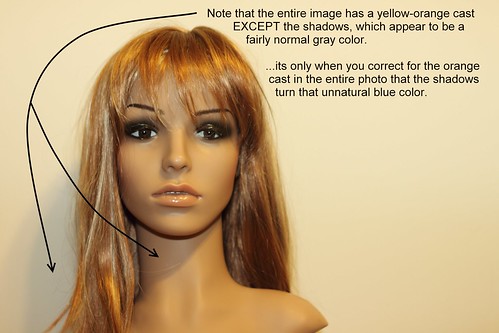The situation is similar to my previous article -I have a model in a room. She's inches from a white wall and lit by a normal overhead light fixture that has a 60W tungsten bulb in it.
Because she's so close to the wall, the overhead light creates a shadow on the wall to the camera's left (her right).
Our eyes generally adjust for the yellow/orange cast of tungsten lighting so we don't even notice it normally. Similarly, if we put our camera's white balance on "Tungsten" then our camera can adjust for the color balance too. (Auto white balance can be hit or miss.) So, if we take a photo without flash it'd come out just fine as far as the color is concerned -we could just adjust for it.
But, if we add a second light source by taking the photo with flash, this is what you get:

Notice the unusually blue-colored shadow areas. Why did that happen? Well, it may help to turn the white balance to "Daylight" in order to see what the photo looks like when the tungsten light isn't corrected for:
Note that the room light (the yellow/orange tungsten light) is creating those shadows because the light from the tungsten light isn't reaching those areas. Then, when we use flash we're adding light to the whole scene INCLUDING those shadowed areas. But the light from the flash is white while the room light is that yellow/orange color. So, uncorrected, what you see is a lot of yellow/orange cast with normal gray shadows -because the flash filled those in, they don't have the same orange tint to them.
Then, if we correct for the orange cast with a white balance setting in our camera or in software after the photo's been taken -here's what actually happens: Remember the color wheel? Opposite of orange is blue, so to make orange go away, the computer adds blue to it. If we add enough blue for the background to look white, the same amount of blue is added to those already neutral gray shadows, so they look blue! ...so now we know why we got the results we did for the first photo, and we can work on fixing it.
What we need to do is to make all of our light sources the same color. That way, when we correct for the tungsten light the shift towards blue doesn't make our shadows blue. So, if we put a yellow/orange gel on our flash, here's what we get (after color correction):
Pretty neat, huh? All you have to do is gel your flash so it matches the light in the room. If it's tungsten light, then use an orange gel. If it's fluorescent light than you'd usually use green. Trying to color match yourself can be hit or miss, so gels are sold that match your average tungsten and fluorescent light perfectly.


No comments:
Post a Comment